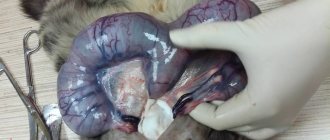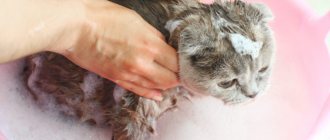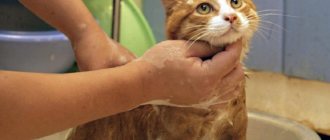8234Pavel
Cat owners sometimes wonder whether it is possible to bathe a pregnant cat at home. In principle, pregnant cats can lick their fur with their own tongue, thereby replacing your decision to wash it. Considering this and the fact that the sebaceous glands of cats secrete useful and necessary substances, there is no need to wash your beauties of any breed, for example, the Sphynx, too often.
There is no exact answer to this question, but the decision to bathe a pregnant animal does not have any negative consequences.
The nuances of this procedure:
- It is necessary to wash a pregnant cat only if there is a danger of harmful substances entering her body during washing.
- wash it very carefully, as any damage can have a detrimental effect on it;
- To prevent small particles of the detergent from getting inside the body during bathing, you should sometimes replace the cat shampoo with dry scrubs prepared at home. For the base of such scrubs they use oatmeal, starch and powder for small children. Remember that chemicals can ruin a mother's lactation after childbirth.
© shutterstock
Why is it better not to bathe a pregnant cat?
Cats are naturally clean. You may not believe it, but there are thousands of cats that have never been bathed in their lives and this has not led to illness or deterioration in the quality of their coat. While the cat is healthy, it does not need to be bathed unless you are preparing for a show or the pet has not gotten dirty.
Bathing is very stressful for almost all cats. The exception is cat breeds that love water, but it is better not to bathe them during pregnancy.
What happens to a cat while bathing:
- Sharp temperature contrast.
- Damage to the protective lipid layer of the skin, which can lead to itching.
- Complete soaking leading to temporary hypothermia
- In 99% - fear, stress and severe discomfort.
The combination of these factors negatively affects the condition of the expectant mother. If the cat splashes the water too hard, bathing can lead to miscarriage.
In what situations are the risks associated with swimming justified?
As they say, you need to choose the lesser evil. A pregnant cat will have to be bathed, despite the risks, if:
- Toxic substances, such as contact poison, have come into contact with the fur.
- The fur is so dirty that it attracts flying insects.
- The cat got dirty with combustion products - gasoline, diesel fuel, motor oil.
- Glue or other liquid has come into contact with the cat's fur, which reacts with the skin at the molecular level.
- Alkali or acid has come into contact with the cat - thoroughly blot it with paper towels, grease it with oil, and bathe it.
This is interesting: Is it possible to terminate a cat's pregnancy?
How often to bathe
For pets who live in an apartment and do not go outside for walks, it is enough to wash them only once every three months, however, no one has canceled the combing of the pet by the owner. Animals that go for walks, especially if there is a road near the house, need to be bathed at least once every two months; in rural areas, even a free-roaming cat can be washed only three times a year.
You cannot bathe your cat often, as the natural fat layer is washed off, without which the quality of the coat deteriorates, the skin becomes dry, and dermatitis appears.
Alternative to swimming
When we are not talking about contamination that does not entail poisoning, burns or other threats to life and health, the fur of a pregnant cat should be cleaned using alternative methods.
Wool cleaning cloths
Many people don’t even know that there are special wet wipes for cleaning cat (and dog) hair. The wipes are impregnated with a special, gentle solution that:
- Deodorizes wool (unscented wipes are available).
- Hypoallergenic.
- Contains beneficial essential oils - eliminates skin irritation.
- Does not contain alcohol.
Instructions for using wet wipes for cats:
- Choose a time when your cat is relaxed. The optimal time is before bedtime or after play, when the cat is no longer active, but not too tired.
- Pet the cat. To make your pet feel comfortable during the cleaning process, continue to pet him while using the wipes. If the cat is very nervous, ask members seven for help and take breaks.
- Rub the wool smoothly. You should not rub the fur, even if it is very dirty. If there is dried dirt on the fur, place a napkin on top for 10-30 seconds and distract the cat by stroking it. The cat wipes are barely damp, but the special solution penetrates the dried dirt and softens it.
- Moisturize your skin. After removing pockets of contamination, wipe the cat with a clean cloth along the entire length of the body. This is necessary so that the balm and essential oil are evenly distributed over the coat and skin.
Note! Cat wipes have a neutral pH, so they can be used to clean the fur on the face and the skin on the inside of the ears.
Lastly, if the cat has not started to get nervous, wipe the pads of the paws and the spaces between the toes. It is advisable to make this procedure permanent if the cat walks outside.
Dry shampoo
Dry shampoo is a powder similar to powder or starch. Choose the product carefully and read the instructions:
- Look for contraindications - some dry shampoos cannot be used on kittens and pregnant cats.
- Don't buy dry shampoo with anti-parasitic properties.
- Look for a shampoo that contains a moisturizer - it is extremely important to ensure that you do not harm your pet's skin.
Advice: if you have never used dry shampoos, it is better to consult your veterinarian about the choice of product.
Instructions for using dry shampoo:
- Choose a good time to brush the fur - the cat should not be excited.
- Apply shampoo to a small area of the coat and rub it into the coat with a dry cloth or hand.
- Distribute the shampoo over all contaminated areas of the coat and massage them.
- Remove shampoo from the coat using a fine-toothed brush.
- Carefully inspect the fur and skin for powder residue - the cat should not lick it off.
Cleaning and shortening the coat
The safest way to keep a pregnant cat's fur clean is through prevention:
- Brush your cat regularly. It is better to use a special glove.
- If there are spikelets or sticky seeds stuck in the fur, carefully cut off the tangled hairs.
- It is better to shorten the fur of a long-haired cat in advance - the anus area, the riding breeches area, the abdominal area and other areas that will be difficult for a pregnant cat to reach for licking.
Why do you need bathing?
Bathing is not just washing the paws after a walk outside, or when they become very dirty.
The process involves completely immersing the cat in water, and this is done in the following cases:
- for prevention;
- if there are fleas;
- strong dirt has formed on the fur.
Long-haired pets should be bathed more often, especially before exhibition days. Owners often wonder if it is possible to bathe a pregnant cat?
There is no clear answer to this question. In general, pregnancy has no contraindications to swimming.
But, you need to take into account a number of nuances:
- It is recommended to wash pregnant cats only if there is a threat of some harmful or toxic substances entering its stomach;
- Even the smallest trauma can affect children, and their psyche in particular;
- To ensure that shampoo residues that enter the animal’s digestive system do not harm future children, you can often replace regular cat shampoo with homemade dry scrubs. They are based on oatmeal, starch and baby powder. Chemistry can ruin subsequent lactation after childbirth.
When deciding whether it is possible to bathe a pregnant cat in water without violence, keep in mind that the answer will be this: it is still better to turn your attention to other methods of care. For example, your pet needs to be taken to the veterinarian periodically.
He must examine her for the presence of worms, which can harm babies. You also need to make sure there are no fleas. If they are, then ask about a safe method of getting rid of them.
A proper diet and the availability of fresh water are of great importance for health. The cat's litter box must be clean at all times. However, if for essential reasons bathing is irreversible, everything possible should be done to ensure that this process takes place correctly and painlessly.
How to choose shampoo for a cat
Due to the different acid-base balance between humans and animals, it is not necessary to use soap products that people use. This can injure their skin and damage their fur.
The following cat shampoos are used:
- Liquid. They contain a high flushing efficiency. There are different purposes, they wash away dirt well, and the wool becomes pleasant to the touch. If possible, it is worth using an imported, more expensive option. But domestic shampoos are not much inferior in quality. All of them cannot be used more than 3 times a year, because this disrupts the sebum balance;
- Dry ones are simply a salvation when your pet has a panicky fear of water. The difficulty in using them is that some animals do not allow the detergent to be combed out of their fur. This procedure is especially difficult for long-haired cats. Remember that a high-quality shampoo contains substances that have an effect similar to a balm that makes combing easier. It is also good because it is suitable for frequent use, you can safely wash your cat’s hair with it, and it is suitable for bathing before shows;
- Sprays. They have the same functionality as dry shampoos, but are more convenient to use. Additionally, they have a perfume scent and antistatic protection.
How to prepare for the washing procedure
When preparing for a swim, consider the following points:
- Using dry shampoo, which has a consistency similar to powder, will not cause any problems other than combing;
- The cat may be frightened by the sound that accompanies the use of the spray. If this is so, then it is better not to torture her;
- Regular washing is always stressful for a pet, so you need to carefully prepare for it;
- The cat is not fed 4 hours before the bathing process;
- There is an increased risk of injury when swimming in water.
Before taking a bath, you should check the temperature. Meowing pets quickly become hypothermic and, accordingly, catch a cold. The room temperature must be above +22°, and the water must be heated. You can check how comfortable washing will be by sticking your elbow into the basin. It is necessary to achieve the effect that when testing with your elbow, the water is not felt (which is usually observed at its temperature of 36.6°). To protect your pet from colds, owners should avoid drafts in the house.
The cat is a very prudent and sensitive animal. Therefore, she can guess in advance what awaits her ahead. In order to somehow deceive, you simply shouldn’t open the water or a tube of shampoo when you have a pet. She is more afraid not of water, but of the noise it makes when it flows from a tap or splashes in a container.
You need to prepare one basin for bathing, the second for rinsing. But it is best to bathe in the bathtub, and then the cat will not be able to cling to the sides with its claws. Her desire to break free will interfere with thorough washing.
And one more thing: water should be taken according to the level of the pet’s abdomen.
After entering the bathroom, you should not immediately throw the animal into a container of water. It is better to stroke and calm him down, and then carefully put him down. Then wet the wool, and hold it firmly in your hands. Bathing should take place without sudden movements and screams, which can frighten even more. Cat shampoo foams easily and takes a very long time to rinse off. Therefore, it must be applied in small quantities to avoid unnecessary inconvenience.
And the cat should not be poisoned by the remnants of the shampoo, since after bathing it tries to lick its fur in the best way possible. You also need to pay close attention to ensure that no water gets into your ears. This unpleasant moment can lead to a lot of health complications associated with inflammatory processes and diseases of the hearing aid.
The final chord of the whole epic will be drying. The pet is wrapped in a towel and the wet fur is blotted. If he is not afraid of the sound of a hair dryer, then you can speed up the drying process. Never allow your animal to shiver from the cold.
In principle, this is all that is required to redeem your meowing happiness three times a year. Remember that the cat’s psychological state may be disrupted after bathing. But, after a couple of hours, there will be no trace of stress left, and she will trust you again.
Instructions: how to bathe correctly
This is a very careful animal. A pregnant cat, unlike others, can easily guess what events await her in the future. In order to somehow wrap your pet around your finger and wash it, you can simply not open the bottle of shampoo in front of it. She may be more afraid not of the water itself, but of the noise it makes when flowing from a tap or splashing in another container.
Where to begin
In order to bathe a female, you need to prepare one free container for bathing and another for rinsing. It will be better if you bathe your pregnant cat in the bathtub
. In this case, her great love of freedom will not interfere with the careful process of bathing pregnant cats at home. Also remember that the water level should be up to your belly.
At the very beginning of the process, just before bathing the cat at home, you cannot immediately lower the female into the aquatic environment. To calm the animal, pet it, calm it down and then carefully place it in a container of water. Lightly wet the animal's fur while holding the pregnant cat tightly in your hands. This procedure for bathing a pregnant cat should be done gently, without unnecessary and unnecessary movements or screams that can frighten the pet. Apply shampoo in a minimal amount to avoid any discomfort.
Drying
The logical result of this entire washing procedure will be ordinary drying, during which the pet is usually wrapped in a comfortable towel, soaking the wet fur with it. If such an animal is not afraid of the sound of a hair dryer, then the drying time after washing can be greatly accelerated. The main thing is that your pet does not suffer from cold after the procedure is completed.
This is all that is required from you to ensure that your big animal is absolutely happy. Don't be surprised if your pregnant female is in poor condition after you give her a bath. In exactly a couple of hours, not a trace of this stress will remain, and your furry happiness will again be the same as before. Thus, we can say that a pregnant cat can and should be bathed at any stage of pregnancy
, following a certain procedure. Washing an animal is as easy as shelling pears, the main thing is to do it correctly.
Is your cat pregnant and about to give you a litter of kittens? This article is a short list of what you need to know and do if your beloved girl becomes pregnant.
Cats are one of the most beloved pets around the world, ranking second in popularity after dogs. They are soft and affectionate creatures, ready to give joy and love to people, while being less expensive in terms of maintenance. What could be more charming than a little kitten?! But before the kittens appear, you may find that your cat requires increased attention, care, material and time expenses from you, so be prepared for this.
First, you must be examined by a veterinarian. Just like pregnant women, cats also need quality medical care during pregnancy. If your cat has never been to the vet before, now is the time for her first visit.
Secondly, the cat may have worms that can be passed on to the kittens, so it is important to carry out deworming on time to avoid infecting the babies. Of course, this should be done before, not during, but if your cat's pregnancy was not planned, discuss deworming with your veterinarian.
Third, review your cat's diet. Your girl now needs extra nutrition for herself and the kittens. You will notice that your cat eats more than usual and her appetite increases as the pregnancy progresses. At a later date, add kitten food to her regular food.
Fourthly, for a normal pregnancy and the birth of healthy kittens, the cat must drink more, so provide your pet with plenty of fresh and clean water. Change it daily.
Fifth, keep your cat's litter box clean. The litter box will smell a little more as your cat uses it more often.
Sixth, pet, cuddle, and pet your cat frequently during pregnancy. Cats are very affectionate, gentle and loving creatures. They love to be loved. In addition, you will most likely notice severe mood swings in your pet.
Seventh, take care of the cat's cleanliness. In fact, cats with water and shampoo are not a good idea. But you need to brush your pet more often. If you think your cat needs a bath, consult your veterinarian first. Make sure the shampoo you use is safe for pregnant and lactating cats.
Ninth, help the cat find a place where she can safely give birth to her kittens. Find a large but relatively shallow box and cover the bottom with soft cloth. Use old blankets and sheets. Find a secluded place where the mother cat will feel protected and completely safe. If you are in a cold climate, make sure the birth area is warm and draft-free.
And finally, tenth, you must help your pet with... You will notice when it is time to give birth. When your cat goes into labor, she will cry and meow in pain. She may not want to be touched. Be close, but give her some space and privacy.
For caring owners this is often not enough. Our mailbox regularly receives letters with non-standard questions and descriptions of situations of concern to animal owners related to pregnancy in cats. In this regard, we decided to seek advice from high-level specialists. Today, the doctor of the Vega clinic, candidate of veterinary sciences, Alexander Dmitrievich Kablukov, answers the most popular questions about cat pregnancy.
— What tests are best done on a cat before mating?
— It is necessary to be tested for the presence of hidden infections: chlamydia, mycoplasmosis, ureaplasmosis.
A vaginal smear is taken and examined using the PCR (polymerase chain reaction) method. Is it possible to breed cats - brother and sister, father and daughter, son and mother? What are the consequences of inbreeding? - You can, if you want to get mutants. Inbreeding is prohibited for everyone. Such breeding significantly increases the likelihood of developing mutations and genetic abnormalities.
— How long after giving birth can a cat become pregnant again?
- 14 days after giving birth, cats go into heat and can become pregnant again.
— Can a cat get pregnant at 15 years old?
- Yes, but it’s bad for the cat and the offspring.
The birth will not be normal. — What threat to a cat’s health does early (at 7-8 months) and late (after 10 years) pregnancy pose?
— At 7–8 months this is not an early pregnancy.
She is early by the standards of human views, but by the standards of physiology this is a completely normal age. Late pregnancy can threaten the development of diseases of the mother and fetus. How to reliably determine whether a cat is pregnant? Are there any special pregnancy tests for cats? — There are no special tests. The only reliable diagnostic method is ultrasound examination (ultrasound). It is carried out starting from the 30th day of pregnancy of the cat.
— Can a pregnant cat ask for a cat?
- Usually no, this does not correspond to normal levels of hormones in the blood.
If this is the case, then the cat has a pathology. — How to distinguish a real pregnancy from a false one?
— False pregnancy is a neuropsychic disease of an animal in which, after a certain period after estrus, usually two months, the animal begins to show signs of pregnancy: lactation, withdrawal, certain toys appear, which the animal nurses as its own offspring.
This pathology is typical for dogs and does not occur in cats. Does a cat have to gain weight? Does it happen that a cat’s pregnancy is almost invisible? — Some cats do not change their constitution until their last days, and by appearance it can be difficult to distinguish a pregnant cat from a non-pregnant one.
— What does a pregnant cat’s diet consist of? Will professional food be enough for her or should she be given vitamin supplements? Usually there is enough food, just increase the daily volume of the diet. But using vitamin-mineral complexes during pregnancy will never be superfluous.
— What to do if a pregnant cat sheds heavily or her whiskers break off?
— It is necessary to analyze the diet and include vitamins and minerals in it.
— Is it possible to bathe a pregnant cat?
- It is possible if the cat tolerated bathing well before.
— If a pregnant cat periodically mates with a male cat, how can this affect the kittens?
“Usually this does not happen and may indicate a pathology of the animal’s hormonal levels.
But in general, mating cannot harm the fruits. Behavior
— If a pregnant cat ignores the litter box, what could this mean?
- This is not a serious sign, but this can happen, including with the development of inflammation in the bladder.
You need to check your urine. — Is it typical for a pregnant cat to refuse food?
— No, this may indicate the presence of some pathological changes: the appearance of pain, nausea, the development of inflammation, etc.
— Is it harmful for a pregnant cat to lie on a hot radiator all day?
- No.
— Can kittens be harmed if a pregnant cat lies on her stomach?
No.
— Can a pregnant cat make new unusual sounds?
- No, all sounds are normal.
Rather, it is a feature of the behavior of a particular individual. — Is it normal for a cat to become angry during pregnancy, constantly growling and hissing?
- No, this is not normal, but it can occur during pregnancy and childbirth.
In this case, the animal is not allowed for breeding and must be sterilized. Health
— Is it possible to vaccinate a pregnant cat?
— It is not advisable to do this, since vaccination can cause the development of fetal diseases.
— How to rid a pregnant cat of fleas?
- It is best to treat for fleas before pregnancy, but if they are still present, it will be better to treat with mild preparations such as Frontline spray.
— What to do if a pregnant cat has worms?
— If this is detected, then it is necessary to treat the cat with mild preparations, for example, drontal for cats or dosalid.
— Is it a pathology if a pregnant cat has a larger belly on one side than the other?
- No, this may be due to the uneven location of the fetuses in the cavity of the uterine horns.
— What can cause bleeding in a pregnant cat?
- Either with the onset of the birth process, or with pathology of the uterus.
— What does discharge from a pregnant cat indicate?
- Most often this is due to an infection of the uterus or vagina.
— Are diarrhea and vomiting a dangerous symptom in a pregnant cat?
- Such symptoms usually indicate poisoning with something that requires appropriate treatment.
— A pregnant cat sneezes often.
What could it be? - This can be associated either with a cold or with the presence of diseases of the upper respiratory tract, more often with polyps of the nasal passages.
What to do if a pregnant cat falls from a height, but no changes in behavior are observed? How can you tell if kittens have been harmed? — It is necessary to conduct an ultrasound of the uterus to determine bleeding and fetal viability.
Does your pregnant cat have brown growths between the hairs on her chin? What is this and what causes it? - Most likely, this is acne - skin lesions associated with excess sebum production. This manifests itself with a decrease in immunity or with the development of certain metabolic diseases.
— Is it possible to sterilize a pregnant cat?
- This procedure will certainly cause a cessation of pregnancy and lead to a miscarriage.
To terminate a pregnancy surgically, it is better to resort to amputation of the uterus or sterilization of the animal after birth. A pregnant cat does not need special care. But there are some nuances that owners should be aware of. Her diet should change a little, and it is better to avoid physical activity and high jumps, especially in the last stages.
Why is bathing undesirable if the cat is pregnant?
Pregnancy has no contraindications as far as hygiene procedures are concerned. But it is considered undesirable to wash an animal’s fur using shampoo. The product contains many components of chemical origin, including toxic ones. The owners are worried about the future offspring, because the cat can harm the kittens when licking its own fur.
Veterinarians do not give a clear answer to the question about washing pets during this period. It is recommended to avoid water treatments unless absolutely necessary.
But if the cat is accustomed to bathing and the smell of shampoos, then you can wash the animal. If contact with water causes negative emotions in her, then rinsing the wool should be done as carefully as possible. There is no need to make sudden movements, hold the pet by the withers or place it in a bathtub in which the water level is higher than the cat itself.
When swimming, you should follow a number of rules that can simplify the procedure:
- The water temperature should be comfortable for the animal. It is necessary to ensure that the water is not too hot or cold. Otherwise, the pet will catch a cold, and during pregnancy this is very dangerous.
- If the cat does not need to wash its entire body, then you should not soap it entirely. The cat's paws are dirty after a walk - only the fur and toe pads should be washed.
- Shampoos should not be used unless absolutely necessary. If your pet has fleas, then it is more rational to purchase special capsules or a collar that will help remove the parasites. There are also dry shampoos and sprays that do not require contact with water.
It is worth washing a pet only in cases where the use of other hygiene products does not make sense. It is important to take into account the physical condition of the animal and its well-being.
Under no circumstances should you bathe a cat that is having a difficult pregnancy, especially if it is several weeks pregnant. It is worth remembering that not all animals tolerate water procedures easily; for some of them it is a lot of stress.
Bathing cats during shedding, vaccination and quarantine
During bathing, the shedding process accelerates, as washing the coat with shampoo and water removes dead hairs. True, many short-haired breeds, for example, some Siamese cats, Orientals and Rexes, lose a lot of hair during shedding and even sometimes have bald spots on their sides, so it is better not to bathe some breeds during shedding.
Bathing for many meowing pets is an unpleasant, stressful procedure, and if the animal is sick, then bathing it, of course, is not advisable. Drafts can also seriously damage an organism that is still fragile after illness, and during vaccination or quarantine, washing cats by veterinarians is generally strictly prohibited.
How to properly care for an animal's fur?
Caring for a pregnant cat is not difficult, but it is worth remembering some nuances:
- Do not wash your cat's fur with cosmetics intended for humans. Such bathing will negatively affect the animal’s well-being. The cat licks its fur and at the same time is able to swallow the remains of the shampoo. The composition of products for animals or for humans is very different, this can affect the condition of the pet’s skin and coat.
- When drawing water into a bathtub or basin, it is worth considering the height of the pet. It is advisable that the fluid level reaches the abdomen. A pregnant cat should be washed carefully, distributing the soap base with massage movements. The shampoo should be rinsed thoroughly, changing the water several times.
- After bathing, the animal is wrapped in a towel. You should not let her go with wet fur, as she may get sick. If your pet is not afraid of a hair dryer, then you should use it. If it is afraid, then you need to hold the animal wrapped in a towel in your arms for at least a few minutes - until the fabric absorbs excess liquid.
During bathing, it is necessary to calm the cat so that it feels more comfortable. It is worth petting it, scratching it behind the ear - this way the animal will understand that the owner will not do anything wrong and you can trust him.
This is interesting: Which food is best for nursing cats?
Is it possible to bathe a pregnant pet?
Before performing the bathing procedure, it is worth learning about other methods of care that are most suitable for a cat in this situation. You can visit a veterinarian with your cat, he will examine the animal and be able to clean the fur from fleas and parasites, if any. Thus, the risk of harm to the fetus is minimized. You can get advice from your veterinarian about safe grooming methods. If the cat is already accustomed to water procedures and the aromas of detergents, then bathing is allowed. If there are negative associations and emotions with water, it is necessary to wash the fur as carefully as possible, without sudden movements, and do not forcefully hold it by the withers, causing pain.
When bathing, it is recommended to follow specific tips that will facilitate this process:
- The temperature should be comfortable for the pet. You should carefully ensure that the water is warm, and in no case hot or cold, as temperature changes can cause miscarriage or a cold.
- If there is no severe contamination throughout the body, for example, if only the paws are dirty, it is not recommended to bathe the cat completely; it is enough to wash only the pads and fur on the paws.
- It is not recommended to wash your cat with shampoo unless absolutely necessary. If you have fleas and parasites, the right solution would be to purchase skin capsules or a specialized collar. You can use dry shampoo, which does not require water to work.
Why is it not advisable to swim?
If bathing is very stressful for your pet, then it is better to postpone the procedure and do it only in case of severe contamination.
Cats require special care for their coat during pregnancy. When an animal licks itself, it can swallow the remains of detergents with saliva. Taking water procedures is a strong stress for the pet, which will not bring benefits for her and future offspring. But there are situations when bathing cannot be avoided: accumulated dirt and dust on the coat after walks, or if parasites have appeared.
Veterinarians believe that washing a cat with shampoo is undesirable, because such products contain chemical elements.
You can bathe your pet only when using other hygiene products is pointless, and you should take into account the health status of the pet and its general well-being. It is not recommended to take water procedures for those individuals whose pregnancy proceeds with complications, even in the first weeks, as this is a strong stress.
Care
When thinking about whether it is worth carrying out such a process, look for information about other methods of care that will be more suitable for the lady. For example, you can simply take your animal to a professional veterinarian, who will examine her and clean her fur of fleas. At the same time, it will not harm the kitten, which is in the womb. Also, if you wish, you can consult a doctor about possible and safe ways to care for your animal.
To properly care for your pregnant pet, you need good food and fresh water. The toilet should be as clean as possible. If for some reason you cannot avoid washing, then try to do it as correctly as possible.
Types of cat shampoos you can use to wash your pet
In order to wash a pregnant cat with shampoo at home, choose the type that will not harm your star’s body. Below you can see examples of such products that you can use to wash your animal.
- With liquid shampoos, washing will be easy and simple. If you have a chance to buy an imported product, take it, since the domestic product has proven itself a little worse in this regard. Such shampoos cannot be used more than 3 times a year.
- Dry shampoos. They are used if animals are afraid of water, and you want to wash it. The problem with using such shampoos is that some violent animals simply do not allow the shampoo to be combed out of their fur. This is typical for long-haired cats. Dry shampoo may contain substances that make combing much easier.
- Special shampoos. They are completely identical in their functions to dry shampoos, but are much more convenient to use. They also additionally have a pleasant scent that you can choose any day.
In order to wash a pregnant cat with shampoo at home, choose the type that will not harm your star’s body. Below you can see examples of such products that you can use to wash your animal.
- With liquid shampoos, washing will be easy and simple. If you have a chance to buy an imported product, take it, since the domestic product has proven itself a little worse in this regard. Such shampoos cannot be used more than 3 times a year.
- Dry shampoos. They are used if animals are afraid of water, and you want to wash it. The problem with using such shampoos is that some violent animals simply do not allow the shampoo to be combed out of their fur. This is typical for long-haired cats. Dry shampoo may contain substances that make combing much easier.
- Special shampoos. They are completely identical in their functions to dry shampoos, but are much more convenient to use. They also additionally have a pleasant scent that you can choose any day.
Safe cleaning products
When using water procedures for a pregnant pet, it is recommended to select those products that can have the least negative impact on the body. It is worth choosing these:
- Liquid shampoos. It would be more correct to purchase imported goods, because domestic ones are of lower quality. Such substances should not be used frequently, only when the pet is heavily soiled.
- Dry detergents. They are used to quickly clean the coat of dust and dirt if the cat is afraid of water. The main problem with these products is that active pets may not allow their owners to comb them out of their fur and then lick them off. This is typical for cats with long fur. The advantage is that after using this shampoo, the combing procedure becomes much easier.
- Specialized products for pregnant cats. They are similar in action to dry products, but they are often released in the form of a spray, which makes the washing process easier. The composition is the safest, they can be used every time you bathe.
How to recognize pregnancy
During bathing, the shedding process accelerates, as washing the coat with shampoo and water removes dead hairs. True, many short-haired breeds, for example, some Siamese cats, Orientals and Rexes, lose a lot of hair during shedding and even sometimes have bald spots on their sides, so it is better not to bathe some breeds during shedding.
We suggest you read: How to remove a tick from a cat yourself
Bathing for many meowing pets is an unpleasant, stressful procedure, and if the animal is sick, then bathing it, of course, is not advisable. Drafts can also seriously damage an organism that is still fragile after illness, and during vaccination or quarantine, washing cats by veterinarians is generally strictly prohibited.
The gestation period for almost all cat breeds is about 9 weeks. However, this period may be longer or shorter by approximately 7 days. And that's quite normal. During the first few weeks of pregnancy, your cat begins to eat less. Sometimes this condition is accompanied by short-term vomiting and apathy of the animal. After about a month, the cat's nipples turn pink. After a month and a half, embryos are already palpable.
To do this, you need to very gently press on the abdominal cavity. At 6 weeks, the cat's abdomen rapidly increases in size, and the embryos can no longer be palpated individually. Only after 7 weeks can you feel the kittens. Cats at this time begin to behave very restlessly and look for a place to give birth.
In the first month of pregnancy, the cat’s diet does not need to change much. But it wouldn’t hurt to add foods high in calcium, protein and vitamins to your diet. For this you can use special feed. After a month, you can introduce food rich in protein into your pet’s diet.
In the middle of pregnancy, veterinarians recommend starting to feed the animal more often than usual. But there is no need to increase the portions. The cat must not be allowed to gain much weight, otherwise the kittens will be large and the birth will be very difficult. Cats usually lose their appetite a few weeks before giving birth, so there is no need to be alarmed.
If the cat is fed only natural products, the majority of its diet during pregnancy should be meat. And it should only be boiled. In addition, the cat needs fish, boiled eggs, cereals, dairy products and vegetables. In this case, it is necessary to add special supplements containing vitamins and minerals to the diet.
Your cat also needs to drink a lot, so she should always have access to clean, fresh water. You can give your cat a special decoction of raspberry leaves, which is prepared as follows - 1 tsp. leaves are poured with a glass of boiled water. Just before giving birth, the animal can be given nettle leaves. They are poured with boiling water and fed to the cat after cooling. This helps the milk flow.
Pet health
You cannot give the animal even the safest medications during this period. The only thing veterinarians allow are probiotics. Dangerous symptoms during cat pregnancy include high fever, bloody or purulent discharge, lethargy and exhaustion.
During pregnancy, your cat may go into heat. This usually occurs approximately 20 to 25 days after fertilization. During this period, the animal may begin to ask to see cats and behave inappropriately. Often such cats mate with male cats and can become pregnant again. These kittens are born several weeks apart. But there is a great danger that during the “first” birth a miscarriage may occur. Therefore, it is better not to allow this to happen.
Miscarriage can also happen due to poor nutrition, any injury, infection, hypothermia or overheating. If this happens, the cat needs to be taken to the vet immediately. In healthy cats, pregnancy and birth are easy. But the owners still need to carefully monitor the condition of their pet and help her in time. You can do an ultrasound on your cat to find out the number of kittens. It is also important to control the birth of the animal and prevent the cat from giving birth in hard-to-reach places.
It is normal for a cat to have a drop in temperature before giving birth. But its increase indicates that the inflammatory process has begun. And after giving birth, it is best to leave the cat with newborn kittens alone. It is necessary to place a tray and a bowl of food near the box so that the animal is not separated from the babies.











